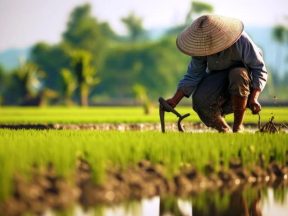Nepal. Between Hope and Uncertainty.
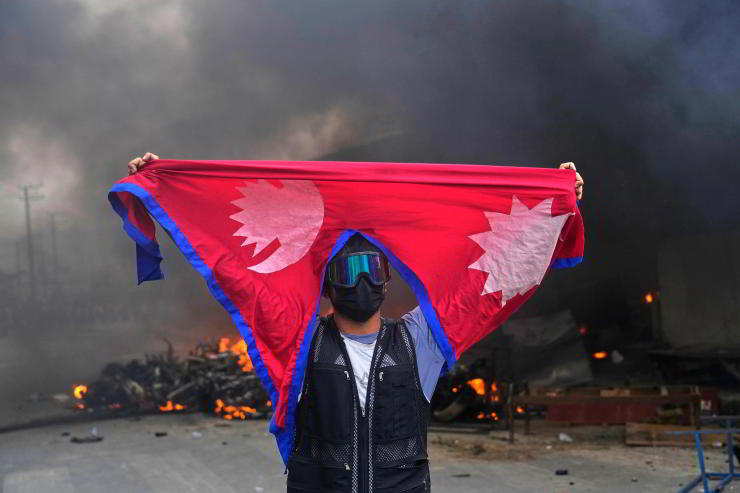
The September uprising against the ban on social media quickly turned into a youth uprising against corruption, nepotism, and lack of prospects. Faced with the crisis, Prime Minister K.P. Sharma Oli resigned and Parliament was dissolved. This paved the way for an interim government led by Sushila Karki, charged with preparing for the elections scheduled for March 2026.
It all began on September 4th with the student mobilisation against the suspension of social media. The ban on 26 social media platforms, including Facebook, Instagram, WhatsApp, and X, turned into a nationwide uprising led by young people, who took to the streets en masse. “Generation Z,” united to defend their freedom of expression, denounced government corruption, nepotism, and the lack of economic prospects. Thousands of young people shouted their anger, while Kathmandu and its valley became the scene of widespread protests, reflecting deep social discontent.
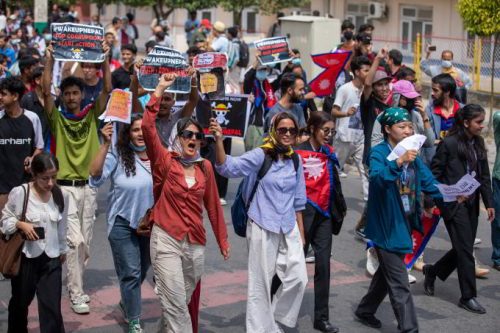
Gen Z Protest Against Nepalese Government. Shutterstock/Pratisha Manandhar
On Monday, September 7th, police fired live ammunition at protesters, triggering a rapid escalation of violence that included clashes and the burning of public buildings. Major centres of power were targeted, and ministers were attacked. Parliament was set on fire, as were several high-level politicians’ residences, luxury hotels, and press offices. The airport was closed, and all international flights were suspended. The death toll has risen to at least 72.
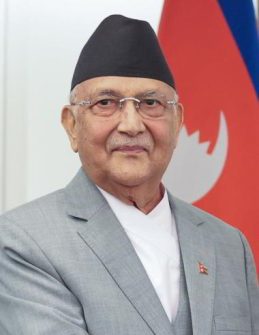
In the face of the crisis, Prime Minister K.P. Sharma Oli resigned. Photo: Prime Minister’s Office
Faced with this youth uprising, Prime Minister K.P. Sharma Oli, who has led Nepal four times since 2015, announced his resignation. “I am taking this decision to facilitate the path to a political resolution and address the challenges ahead,” he said. On September 12, Sushila Karfi, former Chief Justice of the Supreme Court, was appointed interim Prime Minister of Nepal, following a landmark vote on the Discord platform, one of the last accessible social networks. The 73-year-old will head an interim government tasked with ensuring the transition until elections scheduled for next March.“I didn’t want this job. It was after the voices on the street that I was forced to accept it,” she commented. “We must work in line with the thinking of this generation. They are demanding an end to corruption, good governance, and economic equality.”
While young Nepalese now await a response to their demands for transparency and justice, they will have already achieved a major victory: removing the ruling political class, similar to the student uprising that overthrew Sheikh Hasina’s government in Bangladesh last year.
While the ban on social media was the spark, the roots of the uprising run deeper. “Anger over corruption, nepotism, and unemployment has demolished the political elite and calls for radical change,” analyses the Indian weekly India Today. Many young people denounce a political elite that perpetuates privilege and wealth in this small nation of 30 million, which remains one of the poorest in the world and offers no economic prospects. Unemployment is a widespread scourge, and, lacking prospects, hundreds of young people leave Nepal every day to try their luck abroad and take on precarious jobs.
In Kathmandu, political instability has prevailed since the abolition of the monarchy in 2008 and the adoption of the Constitution in 2015, despite the hopes raised by these transitions. For more than two centuries, this ancient landlocked kingdom between China and India was ruled by a monarchy that considered itself the embodiment of national unity. Nevertheless, the country has remained marked by poverty and feudal social structures. In the 1990s, the establishment of a constitutional monarchy failed to lift the country out of its stalemate, with corruption undermining successive governments.
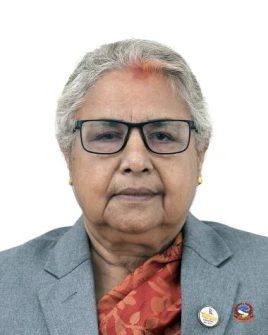
Sushila Karki leads the interim government. CC BY-SA 4.0/ Praveen Shrestha
Maoist guerrillas entered this breach, forcefully denouncing the monarchy’s authoritarianism and inaction. Between 1996 and 2006, more than 16,000 people died in the civil war between rebels and security forces. Meanwhile, the already shaky monarchy was rocked by the “palace massacre” of June 2001, when Crown Prince Dipendra opened fire with an assault rifle, killing nine members of his family, including his father, King Birendra, and his mother, Queen Aishwarya, before turning the gun on himself. In 2006, a peace agreement ended the civil war, while large street demonstrations led to the overthrow of the Hindu monarchy. Two years later, in 2008, the polls handed victory to the Maoists, who had by then converted to the electoral process. The last Hindu kingdom on earth was abolished, and riding a wave of popular enthusiasm, Nepal proclaimed itself a federal republic, hoping to reinvent itself.
Since then, however, the young democracy has struggled to build solid institutions. Corruption, clan wars, and economic stagnation have driven a wedge between the elite and the population. Only in 2015, a year marked by a devastating earthquake, did Nepal finally adopt a constitution establishing a secular, federal republic. This founding text, intended to stabilize the country, has also opened new areas of tension.
The ambiguous definition of secularism has fuelled the mistrust of pro-Hindu movements nostalgic for the old kingdom. Ethnic minorities and marginalised communities, for their part, have denounced an incomplete federalization that perpetuates their exclusion.
Added to this are interparty rivalries that have given rise to chronic instability: since 2008, Nepal has seen more than a dozen governments, impeding the implementation of lasting reforms. Coalitions have proven fragile, governments have repeatedly fallen, and the same politicians remain in power. From crisis to crisis, governments are reformed by the same aging caciques.
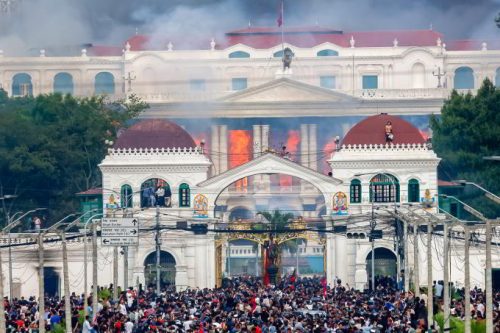
Kathmandu. Gen Z Protesters are burning the Singha durbar (Government offices). Shutterstock/Pratisha Manandhar
Finally, Nepal’s geopolitical position, caught between China and India, remains delicate, and every political manoeuvre resembles a subtle balancing act. Kathmandu is expanding its hydroelectric projects with the help of its two neighbours, both of which are competing for their sphere of influence. Beijing is financing roads and infrastructure as part of the “New Silk Roads,” while New Delhi, a longtime ally, is trying to regain ground. Nepal’s stability depends on the stability of the entire Himalayan region.Between hope and uncertainty, the current political upheaval heralds a crucial period. The transitional government will have to respond to the demands of Nepal’s disillusioned youth, who are demanding real change. Many issues are at stake: the fight against corruption, judicial reform, improved living conditions, and better social representation. The risk of polarization remains, with a monarchist fringe already tempted to demand a return to the past. The challenge for young people is to transform this sudden uprising into a lasting democratic project, ahead of the general elections in March 2026. (Open Photo: A protester holding the Nepalese flag in Kathmandu. Shutterstock/Sathyam_19
(Ad Extra, A. B)


